Over 595 million people speak Spanish globally, and 7.5% of the world’s population are native speakers. Becoming fluent in Spanish allows to communicate with plenty of people for travel, business, personal relationships, etc. However, the language-learning process can sometimes be tedious. It involves repeatedly drilling vocabulary, verb conjugations, and other aspects that don’t always feel engaging or stimulating.
Here’s when mobile applications come into play. They offer short lessons, gamification, immersive experiences, and personalization. Some platforms even integrate quizzes, math courses online and mimic real-life situations to provide a well-rounded educational experience. However, among the countless mobile solutions available, it might be hard to find the best ones. This article provides an overview of the top 12 applications that will help you master Spanish.

Primary focus: Structured lessons with emphasis on practical vocabulary and grammar
G2 Rating: 4.3 out of 5 (21 reviews)
Google Play Link: 4.6 out of 5 (973K reviews)
App Store Link: 4.7 out of 5 (581.3K reviews)
Key Features:
Content: Lessons offer interactive exercises and efficient grammar explanations. The app even provides English hints and translations to accelerate your progress, which is not very common among language learning apps.
Structure: Babbel’s content consists of 2 to 6 courses, each with 5 to 15 lessons. Such an approach helps learners progress step by step in their language journey.
Duration: Lessons are concise and typically take 10 to 15 minutes to complete. The short format makes it easy to learn language throughout the day. It’s one of the best apps to learn Spanish during quick breaks, commutes, or spare moments.
Pricing:
Short, interactive lessons: Babbel's short lessons are perfect for busy schedules, making it easy to practice language daily. These quick sessions prevent overwhelm and maintain consistent learning.
Not for experienced learners: Babbel is one of the best apps to learn Spanish for beginner and intermediate learners. However, advanced users might find they need more challenging content.
Systematic revision: Regular revision is crucial for retaining newly learned language skills. Babbel's review feature boosts memory, making it one of the best apps to learn Spanish.
Insufficient verbal practice: This factor can hinder learners' development of oral communication skills.
Practical grammar instructions: Babbel explains grammar clearly, helping you understand language rules better for accurate communication.
Accurate speech recognition technology: Babbel's speech recognition technology offers immediate feedback on pronunciation.
Conclusion:
Babbel is the best Spanish learning app for intermediate and beginner learners. Lessons are entertaining and short, making it easy to progress through the courses quickly. Babbel includes English translations and explanations. However, for conversational practice, you might need additional resources.
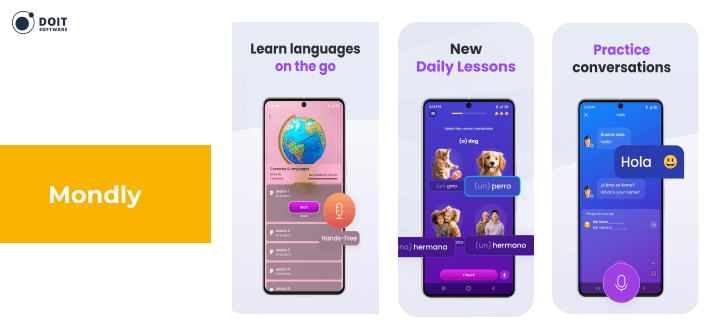
Primary focus: Gamified lessons and augmented reality features
G2 Rating: 4.8 out of 5 (10 reviews)
Google Play Link: 4.7 out of 5 (837K reviews)
App Store Link: 4.9 out of 5 (7.6K review)
Key features:
Structure: There are many different topics to choose from, like weather, family, and travel. Each topic has 6 to 8 lessons.
Content: Lessons have interactive exercises for listening, reading, writing, and speaking skills.
Duration: Each lesson is usually short; you’ll need 5-15 minutes to complete it.
AR technology: AR is what really sets Mondly apart from other language-learning apps. You can use the app to scan your room and then generate a CGI teacher and animations.
Pricing:
Short lessons: Concise lessons make Mondly one of the best apps to learn Spanish. Plus, the interactive nature of the lessons keeps learners actively engaged.
Limited grammar explanations: Some learners may find grammar explanations insufficient.
Budget-friendly:Mondly is affordable and offers great language instruction.
Not for advanced learners: Mondly’s content is great for beginners, but experienced learners might find it too simple. Without advanced content, it's harder to keep improving and moving forward.
VR&AR technology: Mondly uses VR and AR for immersive learning experiences mimicking real-life language situations.
Conclusion:
Mondly is among the best apps to learn Spanish for beginners. It’s not pricey and offers interactive content to facilitate your journey. VR&AR technologies and short lessons are there to keep you engaged. However, you might feel that the content is limited and doesn’t focus much on grammar and speaking.
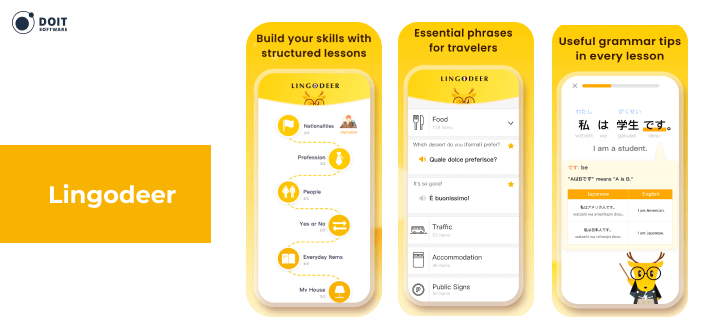
Primary focus: Structured lessons with grammar explanations and practice exercises
G2 Rating: 4.0 out of 5 (1 review)
Google Play Link: 4.7 out of 5 (437K reviews)
App Store Link: 4.8 out of 5 (23.7K)
Key features:
Adaptation: The lessons cover real places and customs that are important in Spanish-speaking regions.
Structure: Each lesson is divided into Learning tips (grammar explanations), Story (short texts or dialogues containing recently introduced grammar), and Lesson Activity.
Content: Lingodeer’s lessons mimic real-life situations, like ordering food or asking for directions, giving learners practical language experience.
Pricing:
Comprehensive lessons: Lingodeer's structured lessons cover many language skills, from basic vocabulary acquisition to advanced grammar concepts.
Insufficient verbal practice: Speaking practice may be less emphasized than other language learning platforms. This could hinder learners' development of oral communication skills.
Entertaining activities: Gamified elements make Lingodeer one of the best apps to learn Spanish. These features keep learners motivated and immersed in the language-learning process.
Limited free content: Some features, such as grammar explanations and practice exercises, may require a premium subscription.
Progress tracking: Built-in progress tracking features allow users to monitor their proficiency levels and learning journey over time.
Conclusion:
Lingodeer is among the best apps to learn Spanish, as it offers structured lessons with clear grammar explanations and interactive exercises. With high ratings on G2, Google Play, and the App Store, it’s well-loved by users. However, there are some limitations, like fewer speaking practice opportunities and features available for premium subscribers only.
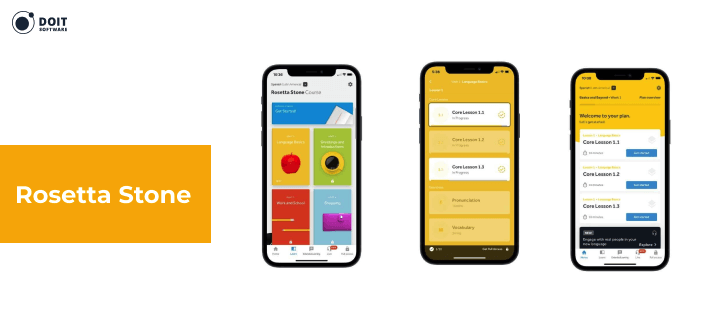
Primary focus: Immersive learning approach with speech recognition technology
G2 Rating: 4.2 out of 5 (106 reviews)
Google Play Link: 4.7 out of 5 (377k reviews)
App Store Link: 4.8 out of 5 (209.3K reviews)
Key features:
Structure: Rosetta Stone is made up of 20 learning units, each of them consisting of 4 lessons.
Content: Audio and image-based content, along with interactive exercises make it one of the best apps to learn Spanish for visual learners.
Techniques: Immersive approach – the platform never provides translations or explanations in the user’s native language. Such an approach requires you to rely on your intuition to learn the language.
Pricing:
Speech recognition technology: Rosetta Stone provides learners with real-time feedback on pronunciation.
Lesson monotony: Some learners may find lessons repetitive or lacking variety.
Plenty of additional resources: Rosetta Stone offers tons of supplementary materials, including phrasebooks and instructional videos.
Insufficient grammar explanations: Rosetta Stone lacks detailed grammar explanations, which could pose challenges for learners who benefit from structured grammar instruction.
Immersive approach: Learners can engage with the language through contextualized activities and authentic materials.
No translations or explanations: Rosetta Stone's way of teaching might be tricky for beginners as it doesn't offer English translations or explanations. This approach may be an obstacle for those unfamiliar with the target language's script or phonetic system.
Image-based content: Visual aids enhance understanding and memory retention. This feature makes Rosetta Stone one of the best apps to learn Spanish for visual learners.
Quite pricey: Rosetta Stone is a relatively expensive app. This factor might be a dealbreaker for budget-conscious users.
Focus on speaking skills: Rosetta Stone prioritizes the development of speaking skills through interactive exercises.
Conclusion:
Rosetta Stone has 20 units with 4 lessons each, giving learners a structured path. Its immersion method helps users pick up the language naturally. It’s good for speaking practice and offers extra resources, but some may find lessons repetitive and lack grammar explanations. Despite these cons, Rosetta Stone is still one of the apps to learn Spanish.
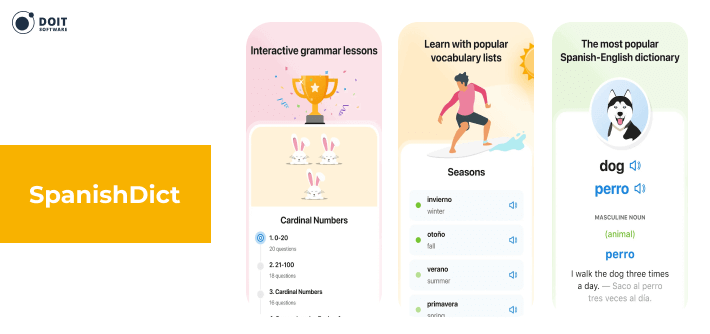
Primary focus: Comprehensive dictionary and language reference tool
Google Play Link: 4.8 out of 5 (76.8K reviews)
App Store Link: 4.8 out of 5 (171K reviews)
Key features:
Content: SpanishDict is one of the best apps to learn Spanish as it gives you many resources. These include interactive grammar lessons and pre-made flashcards to help you acquire new vocabulary. The app allows you to look up words, search for definitions, and view context.
Pricing:
Additional resources: SpanishDict offers a wide range of supplementary materials, including practice exercises, quizzes, and cultural insights.
Insufficient verbal practice: SpanishDict is strong in grammar and vocabulary but lacks writing and speaking practice opportunities.
Coherent grammar explanations: SpanishDict's clear grammar explanations help learners understand language rules for real-life use.
Vocabulary resources: SpanishDict offers various tools and exercises designed to expand learners' vocabulary, including flashcards, word lists, and interactive activities.
Conclusion:
SpanishDict is one of the best apps to learn Spanish if you aim to acquire new vocabulary, view context, and compare synonyms. It’s also a solid fit for those interested in improving grammar.

Primary focus: Connecting users with native speakers for language exchange.
G2 Rating: 4.7 out of 5 (14 reviews)
Google Play Link: 4.3 out of 5 (350K reviews)
App Store Link: 4.6 out of 5 (28.7K reviews)
Key features:
Language Exchange: Tandem is a great tool for finding language buddies and getting your conversational skills to the next level. It takes into account your proficiency, interests, and location before connecting you with other users.
Format: Users can choose the most convenient options to chat via text, voice, and video calls.
Meeting new people: Tandem helps connect people who share language learning goals, allowing for cultural exchange and the chance to make friends.
Difficulty in finding partners: Even with lots of users, finding good language partners can be hard, especially for less common languages or skill levels. This factor may lead to frustration and fewer practice chances.
Delayed replies: Different time zones, busy schedules, and other commitments cause late replies from language partners. This disconnected communication disrupts smooth practice, hindering the learning experience.
Conclusion:
Tandem is a way to go if you’re searching for an app to practice your conversational skills. Here, you can easily find partners based on your goals and preferences. It’s similar to social media apps but for people who want to learn a new language.

Primary focus: An audio-based approach to learning, the best app to learn conversational skills
Google Play Link: 4.9 out of 5 (9.04K reviews)
App Store Link: 4.8 out of 5 (898 reviews)
Key Features:
Methods: The thinking method helps you learn by comparing your native language (English) with the language you’re learning.
Content: This course doesn’t offer written lessons, grammar or speaking exercises, or quizzes like other apps. Instead, it relies solely on the quality and delivery of its audio lessons to engage the learner.
Accessibility: Language Transfer doesn’t require signup or registration, making it easy for users to start learning.
Variety: You can learn eight languages on the platform, with beginner and advanced courses available.
Free access: The language learning platform is completely free for everyone to use.
Insufficient content: There are few opportunities to improve reading, writing, and vocabulary skills.
Short lessons: The platform offers concise audio lessons, each lasting no more than 15 minutes, which are convenient for learners with busy schedules.
Not meant for casual learners: Individuals may find the platform lacking relevant content or practical applications.
Downloadable lessons: Users have the option to download lessons for offline access.
Basic interface: The platform's interface lacks interactive elements, such as gamified activities or social features.
Conclusion:
Language Transfer is a solid choice for learning popular languages despite having fewer resources and features compared to other language apps. It provides a unique learning method that focuses on understanding rather than memorization. However, it’s unsuitable for globetrotters looking for a basic phrasebook.
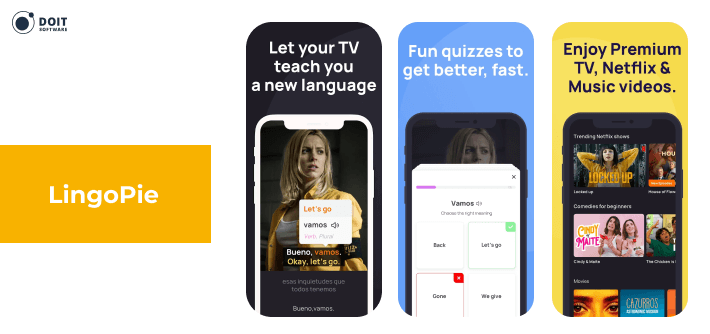
Primary focus: TV shows and movies
Google Play Link: 4.7 out of 5 (2.8K reviews)
App Store Link: 4.5 out of 5 (16 reviews)
Key Features:
Content: LingoPie offers you access to lots of movies with subtitles. The platform also provides grammar explanations grammar and creates automatic flashcards for you to review words.
Personalization: Tailored to each user’s proficiency level, goals, and interests, LingoPie creates customized learning paths for effective language acquisition.
Techniques: LingoPie optimizes vocabulary retention and memory recall through strategic review sessions based on learners’ progress.
Progress-tracking features: Learners receive real-time feedback and can track their progress through interactive quizzes and assessments.
Pricing:
Intuitive design: LingoPie's user-friendly interface and intuitive design make it easy for learners of all ages to navigate the platform.
Inaccuracies: LingoPie's subtitles aren't always correct. Sometimes, clicking on a word shows its literal meaning, which might not match how it was used in the TV show or movie.
Personalized Learning: Custom learning paths match each person's needs. LingoPie tech adjusts to skill levels, how you learn, and goals.
Not beginner-friendly: Some users might find it frustrating due to the lack of a clear learning plan. Additionally, the fast-paced and advanced content may be challenging for beginners. It's better suited for those who already have some knowledge of the language.
Accurate speech recognition technology: LingoPie’s speech recognition technology offers immediate feedback on pronunciation.
Conclusion:
LingoPie stands out as one of the best apps to learn Spanish due to its engaging content, personalized learning paths, and effective techniques. Its comprehensive curriculum covers vocabulary, grammar, listening, and speaking practice, offering an immersive language learning experience.
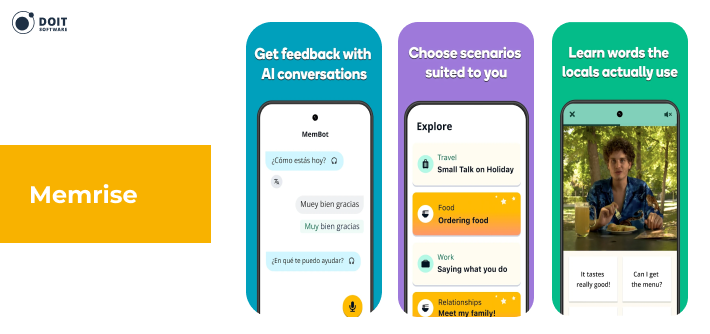
Primary focus: Video lessons and user-generated courses
G2 Rating: 4.6 out of 5 (18 reviews)
Google Play Link: 4.5 out of 5 (1.51M)
App Store Link: 4.9 out of 5 (11.5K reviews)
Key Features:
Content: With Memrise, you can watch native speakers’ videos. You get to see their body language and hear how they pronounce words.
Learning Techniques: Memrise uses spaced repetition, which involves learning a word or phrase and then being prompted to remember it shortly after. This process repeats at intervals over time, ensuring that the information moves from your short-term memory to your long-term one.
User-Generated Courses: Another cool thing about Memrise is that besides their own courses, they also offer user-generated ones.
AI language partner: The feature is called MemBot. It guides users through missions and games, offering varied responses for dynamic learning. Plus, Membot provides support and suggestions, allowing users to practice speaking confidently without a native speaker.
Pricing:
Free plan available: Memrise offers a free plan with basic features. Additionally, even the paid plans are priced affordably.
The free version is limited: Some features are available only to those with paid subscriptions.
Videos of native speakers: Memrise uses videos of native speakers to help learners immerse themselves in the language and culture.
Lack of verbal practice: Memrise may focus more on building vocabulary than practicing conversation, potentially neglecting speaking skills.
Effective vocabulary learning techniques: Memrise helps you learn new words and remember them better using spaced repetition and memory techniques.
User-generated content: Memrise offers a wide range of user-created courses covering niche topics and specialized vocabulary. This way, you can tailor learning to your preferences.
Ability to customize: Memrise offers flexibility in learning session lengths, allowing users to adjust the duration of their study to fit their schedule and learning pace.
Conclusion:
Memrise has great videos of native speakers, an effective vocabulary learning system, and user-created courses. However, it might not be the best Spanish app for practicing conversation skills.

Primary focus: Flashcard app with customizable decks
App Store Link: 4.6 out of 5 (372 reviews)
Key features:
Content: The app uses flashcards to help you learn vocabulary faster. Each of them shows a word or phrase in the language you’re learning, along with its translation or definition in your own language.
Techniques: The app employs the spaced repetition technique, which pushes learners to actively revise and recall words at optimal intervals for memory retention. The method helps you remember things for a long time by spacing out practice sessions and making it easier to learn new words.
Access to other users' resources: The platform offers a variety of user-generated content, such as courses and exercises created by other users.
Free version restrictions: The platform's free version offers only basic features and functionalities.
Knowledge-tracking features: The paid version unlocks additional features, such as tests to track your knowledge and spot gaps. These additional tools enable learners to track their progress more effectively and tailor their study plans accordingly.
Ads: People using the free version might see ads on the platform, interrupting their learning and making it less enjoyable.
Opportunities for pronunciation and spelling improvement: The platform has exercises to help you enhance your pronunciation and spelling. With practice and feedback, you can feel more confident saying words correctly.
Conclusion:
DuoCards is a good option as a supplementary resource if you want to improve your vocabulary effectively. Plus, it is one of the best apps to learn Spanish pronunciation.
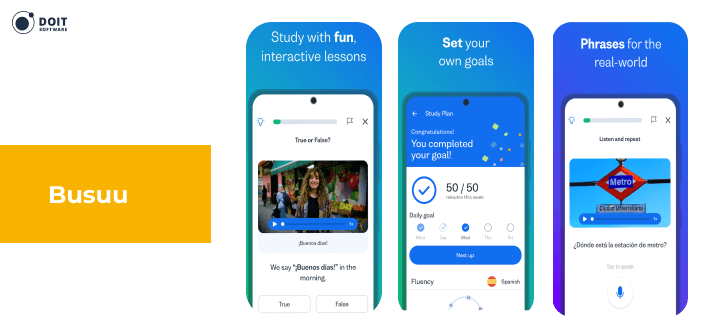
Primary focus: Interactive lessons with native speakers and personalized study plans
G2 Rating: 4.1 out of 5 (24 reviews)
Google Play Link: 4.7 out of 5 (708K reviews)
App Store Link: 4.7 out of 5 (80.7K reviews)
Key features:
Content: Lessons are filled with images, audio recordings, quizzes, and exercises aimed at developing skills in listening, writing, reading, and speaking.
Duration: Short 5-minute lessons with exercises covering the same target words.
AI technology: Bussu, one of the best apps for learning Spanish, uses AI to give tailored vocabulary feedback to users.
Pricing:
Clear grammar guidance: The platform provides concise and easy-to-understand explanations of grammar concepts.
Limited free plan: A paid subscription unlocks grammar lessons, quizzes, customization, and certifications.
Spaced repetition technique: The platform optimizes learning efficiency and memory retention by scheduling review sessions.
Lacking verbal practice: The platform might not focus enough on speaking practice skills.
Cultural insights: Learners gain cultural insights, which are important for understanding the language's nuances.
Lack of entertainment: Some learners may find the platform's content dry and lacking engaging features.
AI progress tracker: The platform uses AI to track your progress and give you advice on how to improve.
Questionable quality: Certain language courses may need to catch up in terms of accuracy, relevance, or instructional value.
Conclusion:
Bussu offers a quality course if your target language is Spanish. Lessons consist of images, audio recordings, quizzes, and exercises. Moreover, Busuu went out of its way to provide users with cultural tips. Despite these pros, the free version is limited, so if you decide the app is right for you, you’d require a paid subscription.
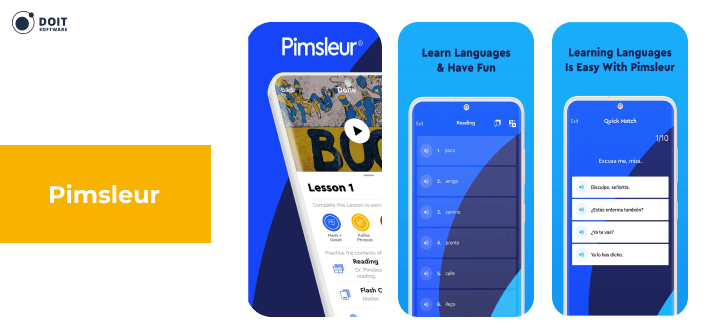
Primary focus: Audio-based approach for building conversation skills
G2 Rating: 4.3 out of 5 (2 reviews)
Google Play Link: 4.3 out of 5 (10.7K reviews)
App Store Link: 4.7 out of 5 (14.4K reviews)
Key features:
Effective Learning Method: Spaced repetition helps users learn new words by showing them frequently and reducing exposure to older ones.
Structure: The app offers 5 levels, each with 30 lessons.
Content: After the main audio exercise, you reinforce learning with reading, flashcards, quizzes, pronunciation practice, and speed games.
Pricing:
Short audio lessons: You can incorporate language learning into your busy schedules.
Reading or writing practice: The platform may need more emphasis on reading and writing practice activities.
Cultural explanations: Adding cultural insights and explanations helps learners better understand the language and its context.
Boring lessons: Some learners may find the pace of the lessons slow.
Practical vocabulary: The platform prioritizes teaching basic vocabulary relevant to everyday communication.
Insufficient grammatical explanations: Learners might find the grammar explanations unclear or not detailed enough. For this reason, they might need extra help to understand some concepts better.
Downloadable lessons: Learners can download lessons for offline access, enabling them to study and complete lessons anytime, anywhere.
Conclusion:
Pimsleur might be one the best apps to learn Spanish for busy people who struggle to squeeze the language learning process into their schedule. It’s also a good fit for those interested in learning everyday vocabulary, such as some basic phrases for a short trip. But when considering if that’s the right option for you, keep in mind that the app lacks thorough grammar explanations and could be more entertaining.
Michigan State University conducted a study in 2020. The purpose was to determine whether mobile applications are effective in learning languages. 85 undergraduate students used Babbel (dissected earlier) to learn Spanish for 12 weeks. The experiment was test-based, meaning each student had to take a test to assess their grammar, vocabulary, and speaking skills. They were required to take the same test at the beginning and end of the study. The results showed that students improved in grammar, vocabulary, and speaking skills.
Overall, this study proves the effectiveness of language learning apps. However, it also shows that your progress is highly correlated with the amount of time you’re ready to invest.
Students learn better when immersed in the language they’re studying, either at school or abroad. Language courses often mimic this immersion by focusing on emotions, exposure, and meaningful context.
How can we create immersive experiences?
Not everyone can spend a lot of time studying or traveling abroad. But thanks to globalization and digitalization, language learners now have opportunities to practice the language by:
To sum up, the language learning process can sometimes be tedious, requiring lots of commitment and attention. Be aware of your strengths and weaknesses when choosing the best Spanish learning apps for yourself. Consider using several mobile applications at a time; this way, you can benefit from the various features each offers. Remember to slowly but steadily incorporate the target language into your routine by watching movies, listening to podcasts, reading books, and using language learning apps.
Hopefully, this list of the best apps to learn Spanish comes in handy. If you feel something is missing or have suggestions, please feel free to reach out!
Get a consultation and start building your dream team ASAP.
CONTACT USBabbel, LingoPie, Rosetta Stone, and Pimsleur are among the most effective apps for learning Spanish.
Language apps are useful for building basic skills, but achieving fluency requires more than just apps. It needs exposure to real-world use of the language and regular practice with native speakers.
It can take around 480 hours of active learning, such as with a teacher, conversation partner, and homework, for a beginner to achieve conversational fluency in Spanish when studying for one hour per day.










